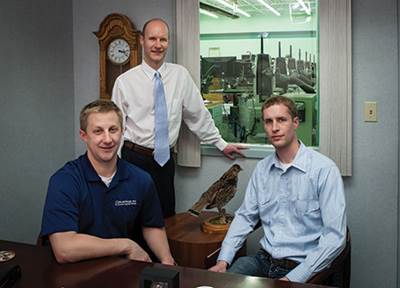Putting 3D Printing to Work
Micro Mold and Plastikos together have invested more than $400,000 in technologies and processes related to 3D printing and reverse engineering over the last three years.
Share
Read Next
Micro Mold and Plastikos together employ more than 100 employees across 75,000 square feet of engineering, design and manufacturing space to provide moldmaking and custom injection molding for challenging tight-tolerance plastic injection-molded parts. Both companies have invested more than $400,000 in technologies and processes related to 3D printing and reverse engineering over the last three years.
Our use of 3D printing varies depending on the specific application at hand. For example, in our molding operation, we use our 3D printer (dimensions: 19.9” by 13.31” by 27.09” with a printing plate 7.8” by 8.5” by 11.8”) to develop various components and fixtures that we use for product handling and cavity separation, such as end-of-arm-tooling grippers. However, this work is limited to the tolerances 3D printing can achieve. We also use 3D printing to streamline up-front product development and support for our OEM customers. For example, reverse engineering existing product designs to identify further opportunities to reduce wall thickness, simplify part design and improve cycle time.
We have experienced several major advantages of 3D printing over traditional manufacturing techniques like machining. For example, our engineers can customize a fixture for end-of-arm tooling in a fraction of the time and cost it would take using traditional manufacturing techniques. From there, these custom fixtures can be used within our manufacturing cell to enhance product handling, cavity separation, and sorting a potential non-conformance.
We recently created an automation engineering position within Plastikos to focus on expanding the company’s use of 3D-printed techniques within manufacturing and identifying opportunities to improve product handling, and in-line product containment and inspection.
Although there are advantages to using a 3D-printing approach, limitations do exist when prototyping. For example, 3D printing cannot account for how gating, cycle time and mold design will impact a plastic part. 3D printing is a completely different process when compared to injection molding. 3D printing is only producing the physical part, and it does not account for the runner system that is required for the injection molding process during mass production for our customers.
We recently created an automation engineering position within Plastikos to focus on expanding the company’s use of 3D-printed techniques within manufacturing. It will also identify opportunities to improve product handling and in-line product containment and inspection.
From a tooling standpoint at Micro Mold, we continue to research additive manufacturing techniques, specifically laser sintering, which have the potential to be used to produce cavity blocks and mold and part geometry for applications where conformal cooling is warranted, as this approach has the potential to reduce lead times and cycle times.
We want to understand better the types of parts each 3D printing process can print, their limitations, future development plans, and any post-processing requirements to finish the part to specifications. We also are looking for third-party equipment reviews that test and compare the capabilities of the various machines and technologies in the marketplace. We are not currently focusing on one additive technology. Instead, we continue to focus on staying abreast of the various technologies in the market and their capabilities to ensure that we are utilizing the technologies where applicable.
For More Information
Micro Mold Company / 814-838-3404 / rkaten@plastikoserie.com / plastikoserie.com
Related Content
Solving Mold Alignment Problems with the Right Alignment Lock
Correct alignment lock selection can reduce maintenance costs and molding downtime, as well as increase part quality over the mold’s entire life.
Read MoreLaser Welding Versus Micro Welding
The latest battle in finely detailed restoration/repair of mold materials.
Read MoreTreatment and Disposal of Used Metalworking Fluids
With greater emphasis on fluid longevity and fluid recycling, it is important to remember that water-based metalworking fluids are “consumable” and have a finite life.
Read MoreRead Next
2013 Leadtime Leader Awards: Honorable Mention Micro Mold Company, Inc.: Partnering to Push the Limits
This mold manufacturer wins the 2013 Leadtime Leader Honorable Mention title because it exceeds expectations with a team mentality—stemming from its youthful leadership working closely with skilled tradesmen—that sees customers, its sister molding company and industry associations as true partners.
Read MoreAre You a Moldmaker Considering 3D Printing? Consider the 3D Printing Workshop at NPE2024
Presentations will cover 3D printing for mold tooling, material innovation, product development, bridge production and full-scale, high-volume additive manufacturing.
Read MoreHow to Use Continuing Education to Remain Competitive in Moldmaking
Continued training helps moldmakers make tooling decisions and properly use the latest cutting tool to efficiently machine high-quality molds.
Read More





















